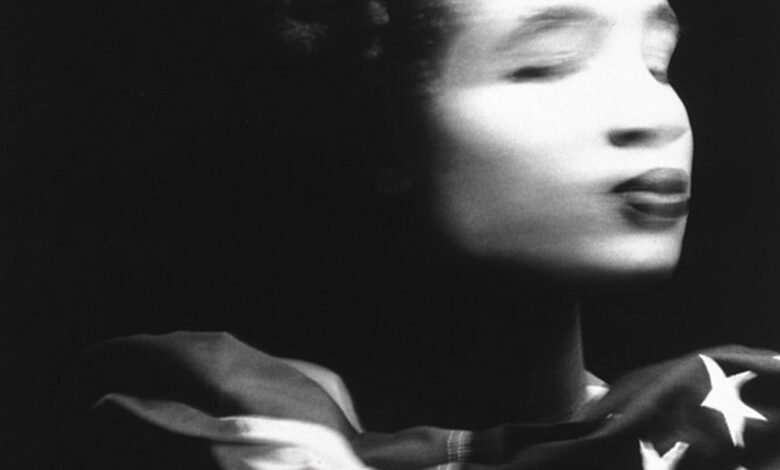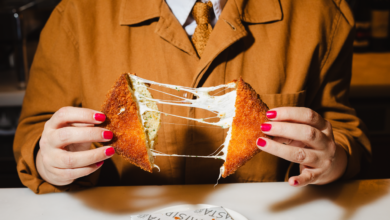Flag Waving and Flag Burning in Kamala Harris’s America

The D.N.C. looked like the R.N.C. Apparently, during the harried month that passed between the recusal of Candidate Biden and the mounting of Candidate Harris, the campaign underwent a large image overhaul. The D.N.C. looked like the R.N.C., by which I mean, the Convention center in Chicago gave off the vapors of the Republican aesthetic. The American flag, the lodestar of the Republican look since Nixon, took over. Crowd shots on network television featured many miniature flags waving. It was not simply the ocean of flags that mattered, from the image perspective, but the multiracial lot that was holding them. One of the ways the opposition sought to discredit the Convention, which drew, it looked to the eye, substantially more people than the G.O.P. ceremonies, was to spread rumors online that the flag was not present at the center, as part of a larger claim about Democrats not being patriotic. “JUST IN: Missing from the DNC in Chicago . . . The American Flag,” one social-media post read. The attendees were able to joyfully refute this.
One strategist said, “Reclaiming the flag and reclaiming freedom and democracy—I think that was a feeling broadly.” The point is to make the latter-day G.O.P.’s embrace of the flag—Trump does it literally, he hugs it—seem like a molestation or desecration in comparison. To strip those deeply entrenched dispatches of marching white supremacists in Charlottesville of their canonization. To reclaim patriotism—this is what the Party of Harris, stupefied upon its renovation, wants to perpetuate as its chief seduction to the so-called moderate Republican, who isn’t moving to the next political neighborhood over without bringing her Stars-and-Stripes pendant with her.
Four days after Kamala Harris’s campaign was announced, she released a vicious statement against protesters of Benjamin Netanyahu, the Prime Minister of Israel, who had come to the U.S. to address Congress, in July. The demonstrators had burned flags, a method of objection nearly as old as patriotism itself. Harris’s statement smeared these protesters as antisemitic defenders of Hamas; it associated flag burning with the hatred of a people. The statement disappears Palestinians, making no mention of the tens of thousands of people killed in Palestine. The rhetorical heat comes from the defense of the flag, which shrouded the early days of the Harris campaign in a kind of reasonableness, even as it was committing an unreasonable erasure. What else is a Presidential candidate meant to say when someone puts fire to the fabric? Surely, she could not possibly consider the moral desperation of the agitators.
Who can claim America as their own? One of the performers at the D.N.C. was Mickey Guyton, a Black country singer. Wearing a white dress that transformed her into a goddess of the Republic, she belted her song “All American”: “We got the same stars, the same stripes / Just wanna live that good life / Ain’t we all, ain’t we all American?” The song of the patriot Guyton, who has had to endure the racism of Nashville, has an unconscious innocence. It seemingly references the famous Sojourner Truth line—“Ain’t I a woman?”—that some scholars believe to be a misrepresentation of Truth’s real address.
“Love of country,” as Frederick Douglass analyzed, is a difficult essence to stir in the heart of the Black American. This past year, there has been a surfeit of so-called recontextualized patriotism, brightened and Blacked up, made sexy, in regions of culture outside of politics. There is Beyoncé, who let the Harris campaign use her 2016 song “Freedom,” featuring Kendrick Lamar, as its anthem. “Freedom” is a cut-and-dry protest song, about breaking chains and conquering troubled water. (The Lamar verse—“Stole from me, lied to me, nation hypocrisy”—isn’t getting spotlighted at Harris’s rallies.) The iconography of Beyoncé’s most recent album, “Cowboy Carter,” is rife with straight Americana—bluejeans, big hair, the big flag that she holds while straddling a horse. But observers hoping to detect any exciting irony in Beyoncé’s invocation of the flag will come up empty. The argument buttressing the patriotic images is an earnest one: that Black America ought to feel ownership of the country it built. There is an absorption of nationalism critique, in this way of thinking, a strike against nihilism. The sentiment—rah-rah but respectful of the ancestors’ blood—got lent to the Olympics, which counted Beyoncé as one of its celebrity endorsers. Lamar, emerging even more intensely as a kind of bard of Black authenticity this year, blended his artiness with the National Football League, announcing that he would perform at the 2025 Super Bowl. In the commercial promoting his halftime performance, he’s shooting pigskins on the field, the flag backgrounding him. Almost a decade ago, not long before Colin Kaepernick started kneeling, Lamar was stepping on a cop car as the flag waved behind him, performing “Alright.” As the song’s lyrics go, “Lookin’ at the world like, ‘Where do we go?’ / Nigga, and we hate po-po / Wanna kill us dead in the street for sure, nigga.”
What happened between then and now? I don’t know whether we get far enough analytically if we chalk up the change to a mass degradation of the soul or a collective selling out, although that’s happening, too. The iconography of this country is so ubiquitous as to be symbolically moot. It is too much symbol—of violence, of imperialism, of ingenuity, of segregation, of hope. It is the spiritual deadness that is conveyed, not the jingo pride, as the cooler kids take up the Stars and Stripes in 2024.
The other day, I went to go see “Flags: A Group Show,” at Paula Cooper Gallery, in Chelsea, which brings together, in one crowded room, dozens of twentieth- and twenty-first-century works that interrogate patriotism and national identity. I would have said the flag-as-muse theme was retro for a show in 2024, had the campaign season gone differently. The questioning of the flag in the art world is a twentieth-century tradition. Newer works can feel iterative, paling in vitality, recombinant critiques. But now the show seemed relevant, not nostalgic. The works in “Flags” responded to war, assassination, economic collapse, police violence; the artists, no matter where they were born, were made by the country and vice versa. The curator, Steve Henry, was at the gallery the afternoon that I visited; he told me that the idea for the show had come to him in a period of anguish last summer. He pointed out a work to me by Claes Oldenburg, “The Old Dump Flag,” a sculpture made from wood which evokes the stripe schema of the flag. Looking at the piece, we think of America as troublingly primordial, almost natural. How to think of the world outside of its influence? Like thinking of the world without its most elemental building material.
The Oldenburg is joined by some extremely well-known works, such as “African-American Flag” by David Hammons, “American Gothic, Washington D.C. [Ella Watson]” by Gordon Parks, “Collateral” by Hans Haacke, and Lyle Ashton Harris’s “Miss America,” a photo in which a black woman, baring her breast, is wrapped in a flag, her face done up in whiteface. Harris’s photograph, made in the eighties, spoke to the segregated culture of pageantry, how the Black woman’s body is the vessel through which America came to be. A visitor to the gallery may not know any of this. Works are not flanked by explanatory wall text. The dense organization of the walls—some sculptures occupy the center but most else is on the wall—creates anxiety. That deadness you might feel, say, when the celebrity puts on the colors is undone, replaced with something alive, aching to get out. You hear a ticking, in the gallery, when you enter. The sound comes from Josh Kline’s sculpture, “Make-Believe,” a reconstructed blender sat on a wooden stool; it whips up the spectre of the omnipresent threat that justifies so much American destruction. The sculpture, a study of paranoia, is as much a synecdoche for American identity as are the more literal representations in the room. It’s also wry, as is Rachel Harrison’s “© 2004 Hasbro Inc.” The sculpture makes the body of a worker out of a box, a plastic wrap, and a rope. A hard hat emblazoned with the flag tops the sculpture, which is placed on a rolling cart. Fake sausages and a toy gun are like garlands. An idiom comes to mind, circling this audacious piece, that gets us thinking about manufacturing and militarism: “How the sausage gets made.”
Many works in the show were made by artists of color. (And note that a good deal of the white artists included—Diane Arbus, Robert Frank—were outsiders to their race, and made it a project of their observation to home in on difference.) Artists of the latter generation talk to their predecessors. It can be said that the flag possessed a young Jasper Johns, back in the States after doing military service in Korea, and there are works at Paula Cooper that explicitly inherit Johns. Chakaia Booker’s “Feeding Frenzy,” from 2012, is fabricated through layering, like Johns’s flags, but she has used tire and steel, in the stead of newspaper, to build her all-black flag—evoking officers in the police cruiser, one thinks, and the people they have run down. Jonathan Horowitz and Eric N. Mack, both contemporary artists, also create flag motifs issuing from the tradition of Johns.
In the photographs, the flag meets the body and something chemical happens. The photographer Gordon Parks knew Ella Watson, a government worker. For his “American Gothic,” he had her pose in front of a flag and hold up a broom and a mop, creating as indelible an image as the painting from which he takes his title. Parks’s photograph was made in 1942, just twelve years after the famous Grant Wood painting.
I’ve always thought of the Parks photograph, the subdued rage in it, as an antecedent for “What Is the Proper Way to Display a U.S. Flag?,” Dread Scott’s work displayed at the School of the Art Institute of Chicago in 1989, which had visitors walk across a flag, laid on the ground, to testify to their experiences of marginalization on a ledger. The piece drew the ire of President George H. W. Bush; that same year, the Supreme Court issued a landmark ruling protecting the “desecration of the flag” under the First Amendment. The artist helped change the flag and vice-versa. The piece is what you’re taught in school to disavow you of the idea that art is unimportant.
In the beginning of October, more than a hundred and sixty artists, many of them famous, contributed works to an ongoing auction called Artists for Kamala, to benefit the Harris campaign. Artists making not just art but money: the goal is to bolster one of the more well-funded campaigns in modern American history. But the point is to give Harris the imprimatur of the civilized, the art-makers, and to have that endorsement enhance the reputation of the country, which they feel they must save from the G.O.P. In this year of indeterminate killing, sanctioned by the flag, this is said to be the responsibility of the artist. ♦




